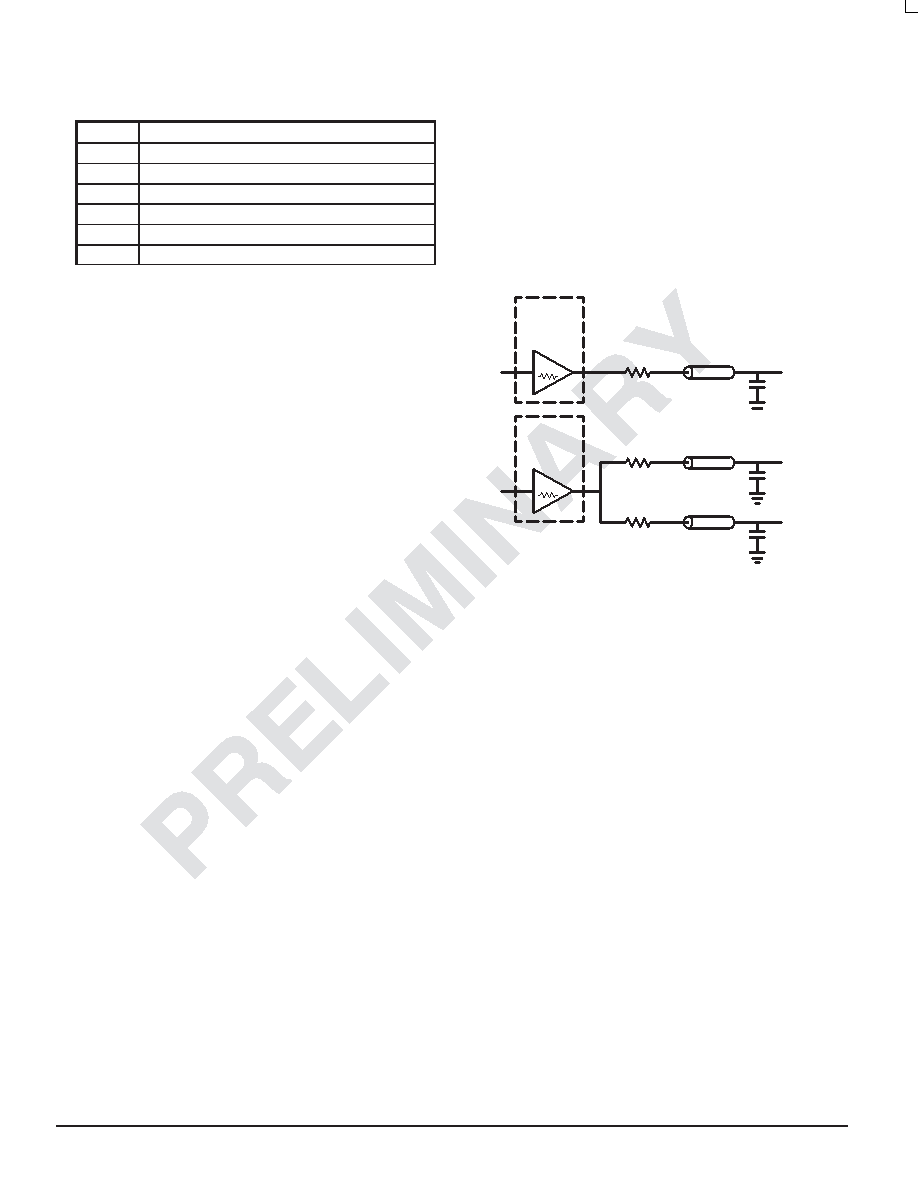- 您現(xiàn)在的位置:買賣IC網(wǎng) > PDF目錄25632 > MPC97R73FA (MOTOROLA INC) PLL BASED CLOCK DRIVER, 12 TRUE OUTPUT(S), 0 INVERTED OUTPUT(S), PQFP52 PDF資料下載
參數(shù)資料
| 型號(hào): | MPC97R73FA |
| 廠商: | MOTOROLA INC |
| 元件分類: | 時(shí)鐘及定時(shí) |
| 英文描述: | PLL BASED CLOCK DRIVER, 12 TRUE OUTPUT(S), 0 INVERTED OUTPUT(S), PQFP52 |
| 封裝: | LQFP-52 |
| 文件頁(yè)數(shù): | 5/20頁(yè) |
| 文件大小: | 252K |
| 代理商: | MPC97R73FA |
第1頁(yè)第2頁(yè)第3頁(yè)第4頁(yè)當(dāng)前第5頁(yè)第6頁(yè)第7頁(yè)第8頁(yè)第9頁(yè)第10頁(yè)第11頁(yè)第12頁(yè)第13頁(yè)第14頁(yè)第15頁(yè)第16頁(yè)第17頁(yè)第18頁(yè)第19頁(yè)第20頁(yè)

MPC97R73
TIMING SOLUTIONS
13
MOTOROLA
Table 14: Confidence Facter CF
CF
Probability of clock edge within the distribution
± 1s
0.68268948
± 2s
0.95449988
± 3s
0.99730007
± 4s
0.99993663
± 5s
0.99999943
± 6s
0.99999999
The feedback trace delay is determined by the board
layout and can be used to fine-tune the effective delay
through each device. In the following example calculation a
I/O jitter confidence factor of 99.7% (
± 3s) is assumed,
resulting in a worst case timing uncertainty from input to any
output of -495 ps to 495 ps1 relative to CCLK:
tSK(PP) =
[–300ps...300ps] + [–150ps...150ps] +
[(15ps
@ –3)...(15ps @ 3)] + tPD, LINE(FB)
tSK(PP) =
[–495ps...495ps] + tPD, LINE(FB)
Due to the frequency dependence of the I/O jitter,
Figure 9. “Max. I/O Jitter versus frequency” can be used for a
more precise timing performance analysis.
Figure 9. Max. I/O Jitter versus frequency
TBD
See MPC961C application section for
an example I/O jitter characteristics
Driving Transmission Lines
The MPC97R73 clock driver was designed to drive high
speed signals in a terminated transmission line environment.
To provide the optimum flexibility to the user the output
drivers were designed to exhibit the lowest impedance
possible. With an output impedance of less than 20
the
drivers can drive either parallel or series terminated
transmission lines. For more information on transmission
lines the reader is referred to Motorola application note
AN1091. In most high performance clock networks
point-to-point distribution of signals is the method of choice.
In a point-to-point scheme either series terminated or parallel
terminated transmission lines can be used. The parallel
technique terminates the signal at the end of the line with a
50
resistance to VCC÷2.
This technique draws a fairly high level of DC current and
thus only a single terminated line can be driven by each
output of the MPC97R73 clock driver. For the series
terminated case however there is no DC current draw, thus
the outputs can drive multiple series terminated lines.
Figure 10.
“Single versus Dual Transmission Lines”
illustrates an output driving a single series terminated line
versus two series terminated lines in parallel. When taken to
its extreme the fanout of the MPC97R73 clock driver is
effectively doubled due to its capability to drive multiple lines.
Figure 10. Single versus Dual Transmission Lines
14
IN
MPC97R73
OUTPUT
BUFFER
RS = 36
ZO = 50
OutA
14
IN
MPC97R73
OUTPUT
BUFFER
RS = 36
ZO = 50
OutB0
RS = 36
ZO = 50
OutB1
The waveform plots in Figure 11. “Single versus Dual
Line Termination Waveforms” show the simulation results of
an output driving a single line versus two lines. In both cases
the drive capability of the MPC97R73 output buffer is more
than sufficient to drive 50
transmission lines on the incident
edge. Note from the delay measurements in the simulations a
delta of only 43ps exists between the two differently loaded
outputs. This suggests that the dual line driving need not be
used exclusively to maintain the tight output-to-output skew
of the MPC97R73. The output waveform in Figure 11.
“Single versus Dual Line Termination Waveforms” shows a
step in the waveform, this step is caused by the impedance
mismatch seen looking into the driver. The parallel
combination of the 36
series resistor plus the output
impedance does not match the parallel combination of the
line impedances. The voltage wave launched down the two
lines will equal:
VL = VS ( Z0 ÷ (RS+R0 +Z0))
Z0 = 50 || 50
RS = 36 || 36
R0 = 14
VL = 3.0 ( 25 ÷ (18+17+25)
= 1.31V
At the load end the voltage will double, due to the near
unity reflection coefficient, to 2.6V. It will then increment
towards the quiescent 3.0V in steps separated by one round
trip delay (in this case 4.0ns).
1. Final skew data pending specification.
相關(guān)PDF資料 |
PDF描述 |
|---|---|
| MPC9892FA | PLL BASED CLOCK DRIVER, 5 TRUE OUTPUT(S), 0 INVERTED OUTPUT(S), PQFP32 |
| MPC9991FA | PLL BASED CLOCK DRIVER, 13 TRUE OUTPUT(S), 0 INVERTED OUTPUT(S), PQFP52 |
| MQ80C154-16P883R | 8-BIT, 16 MHz, MICROCONTROLLER, CQFP44 |
| 952100202 | 8-BIT, 30 MHz, MICROCONTROLLER, CQCC44 |
| MD80C52EXXX-30SBD | 8-BIT, MROM, 30 MHz, MICROCONTROLLER, CDIP40 |
相關(guān)代理商/技術(shù)參數(shù) |
參數(shù)描述 |
|---|---|
| MPC980 | 制造商:MOTOROLA 制造商全稱:Motorola, Inc 功能描述:DUAL 3.3V PLL CLOCK GENERATOR |
| MPC9817 | 制造商:FREESCALE 制造商全稱:Freescale Semiconductor, Inc 功能描述:Clock Generator for PowerQUICC and PowerPC Microprocessors and Microcontrollers |
| MPC9817EN | 功能描述:時(shí)鐘發(fā)生器及支持產(chǎn)品 FSL 1-5 PwrQUICC/Pwr PC Clk Gen, RoHS:否 制造商:Silicon Labs 類型:Clock Generators 最大輸入頻率:14.318 MHz 最大輸出頻率:166 MHz 輸出端數(shù)量:16 占空比 - 最大:55 % 工作電源電壓:3.3 V 工作電源電流:1 mA 最大工作溫度:+ 85 C 安裝風(fēng)格:SMD/SMT 封裝 / 箱體:QFN-56 |
| MPC9817ENR2 | 功能描述:時(shí)鐘發(fā)生器及支持產(chǎn)品 FSL 1-5 PwrQUICC/Pwr PC Clk Gen, RoHS:否 制造商:Silicon Labs 類型:Clock Generators 最大輸入頻率:14.318 MHz 最大輸出頻率:166 MHz 輸出端數(shù)量:16 占空比 - 最大:55 % 工作電源電壓:3.3 V 工作電源電流:1 mA 最大工作溫度:+ 85 C 安裝風(fēng)格:SMD/SMT 封裝 / 箱體:QFN-56 |
| MPC9817SD | 功能描述:時(shí)鐘發(fā)生器及支持產(chǎn)品 FSL 1-5 PwrQUICC/Pwr PC Clk Gen, RoHS:否 制造商:Silicon Labs 類型:Clock Generators 最大輸入頻率:14.318 MHz 最大輸出頻率:166 MHz 輸出端數(shù)量:16 占空比 - 最大:55 % 工作電源電壓:3.3 V 工作電源電流:1 mA 最大工作溫度:+ 85 C 安裝風(fēng)格:SMD/SMT 封裝 / 箱體:QFN-56 |
發(fā)布緊急采購(gòu),3分鐘左右您將得到回復(fù)。